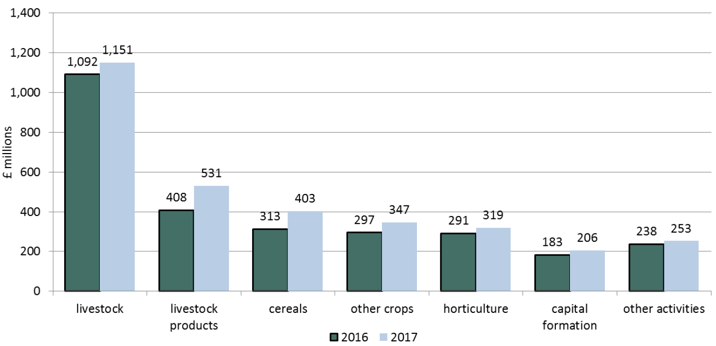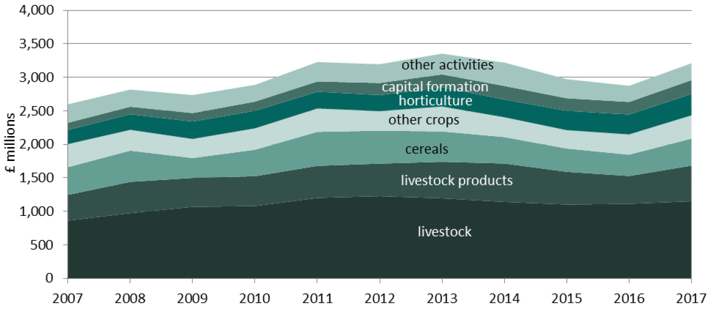Total income from farming: estimates for Scotland 2015-2017
The official measure of the net income gained by the agriculture industry in Scotland.
4. Outputs from Scottish farms
The value of outputs from Scottish farms fell from £2.86 billion in 2015 to £2.82 billion in 2016, but then rose to an estimated £3.21 billion in 2017. Changes in outputs will be due to both changes in volume and in prices.
Chart 4: Output, 2016 and 2017 source: Table 1

The total output of livestock (finished, store sales outwith Scotland, and coupled support) was estimated as £1.09 billion in 2016 (39 per cent of output; up £31 million, three per cent or one per cent real terms) and £1.15 billion in 2017 (36 per cent of output; up £60 million, five per cent or four per cent real terms).
Within this the value of finished and store cattle fell to £686 million in 2016 (24 per cent of output; down £13 million, two per cent or four per cent real terms) but is estimated to have risen to £716 million in 2017 (22 per cent of output; up £31 million, four per cent or three per cent real terms). Both years saw a fairly steady volume, with a drop in price in 2016 followed by an increase in price in 2017.
Finished sheep and lamb output was estimated as £195 million in 2016 (seven per cent of output; up £23 million, 13 per cent or 11 per cent real terms) and £209 million in 2017 (seven per cent of output; up £14 million, seven per cent and five per cent real terms). Changes are due to prices in both 2015 and 2016. Store sheep and lamb output was estimated at £14 million in 2016 and £13 million in 2017, with around £7 million both years in coupled support.
Output of pigs was estimated as £87 million in 2016 (three per cent of output; up £2 million, two per cent, or little changed in real terms) and £108 million in 2017 (three per cent of output; up £21 million, 24 per cent or 22 per cent real terms). Production increased slightly in both years, but 2017 saw a strong increase in price.
Poultry was estimated as £84 million in 2016 (three per cent of output; up £19 million, 30 per cent or 27 per cent real terms) and £80 million in 2017 (two per cent of output; down £4 million, five per cent or seven per cent real terms). 2016 saw a recovery in broiler numbers, before dropping slightly in 2017, with price remaining steady.
Amongst livestock products, the value of milk fell further in 2016 to £317 million (11 per cent of output; down £53 million, 14 per cent or 16 per cent real terms) but rebounded to an estimated £434 million in 2017 (14 per cent of output; up £117 million, 37 per cent or 34 per cent real terms). The average price for a litre fell from 24.1p to 22.0p between 2015 and 2016, with a six per cent reduction in volume to 1.43 billion litres. However, during 2017 the average price increased to 28.2p per litre, which was accompanied by a seven per cent increase in volume to 1.53 billion litres.
The value of eggs for food was estimated at £83 million in 2016 (three per cent of output; down £9 million, 10 per cent or 12 per cent real terms) and £89 million in 2017 (three per cent of output; up £6 million, eight per cent or six per cent real terms). There were increases in production in both years with a drop in price in 2016 followed by a small increase in 2017. The value of egg production in 2017 was estimated as being greater than for poultry production.
Wool accounted for £4 million in both 2016 and 2017.
Other livestock and livestock products includes around £8 million for exported hatching eggs.
Cereals were valued at £313 million in 2016 (11 per cent of output; down £21 million, six per cent or eight per cent real terms) and £403 million in 2017 (13 per cent of output; up £90 million, 29 per cent or 27 per cent real terms). About 60 per cent of this value comes from barley, with barley showing a seven per cent reduction in value in 2016 to £185 million, but a 36 per cent increase to £253 million in 2017, due to an increase in both price and volume. The value of wheat fell in 2016, down to £105 million, but rose to £128 million in 2017, while oats rose 43 per cent in 2016 to £23 million before dropping off slightly to £22 million in 2017.
Amongst other crops, potatoes were valued at £205 million in 2016 (seven per cent of output; up £35 million, 20 per cent or 18 per cent real terms) and an estimated £215 million in 2017 (seven per cent of output; up £9 million, four per cent or three per cent real terms). The increase in 2016 was due to the ware prices, whereas in 2017 an increase in volume offset a drop in price. Seed volumes and prices remained more constant.
Within horticulture, vegetable production accounted for an estimated £130 million in 2016 (five per cent of output; up £21 million, 20 per cent or 17 per cent real terms) and £155 million in 2017 (five per cent of output; up £24 million, 19 per cent or 16 per cent in real terms).
Fruit production accounted for an estimated £136 million in 2016 (five per cent of output; down £4 million, three per cent or five per cent real terms) and £134 million in 2017 (four per cent of output; down £2 million, one per cent or three per cent real terms). While the trend in vegetables continues to rise, there have now been two years of small drops in the value of fruit.
Capital formation, which in financial terms recognises the value of putting livestock into the breeding herd rather than slaughter, was estimated at £183 million in 2016 (six per cent of output; up £3 million, two per cent or no change real terms) and £206 million in 2016 (six per cent of output; up £23 million, 12 per cent or 10 per cent real terms).
Other agricultural work accounted for £74 million in 2016 and was estimated at £81 million in 2017 (three per cent of output in both years), with income from non-agricultural activity [2] estimated at £164 million in 2016 (six per cent of output; down £27 million, 14 per cent or 16 per cent real terms) and £172 million in 2017 (five per cent of output; up £8 million, five per cent or three per cent real terms).
Chart 5: Value of outputs, in real terms, 2007 to 2017 source: Table 3

Contact
There is a problem
Thanks for your feedback